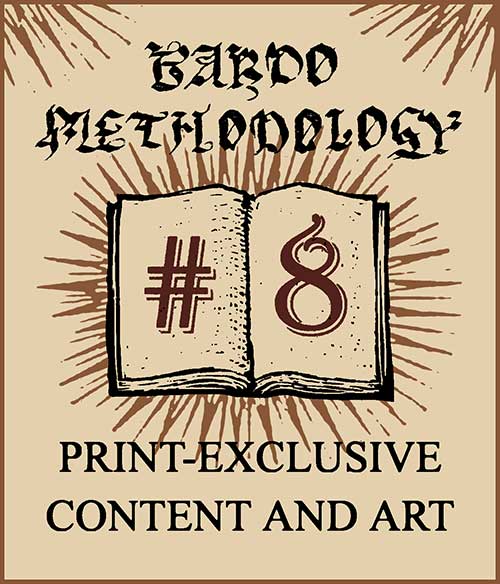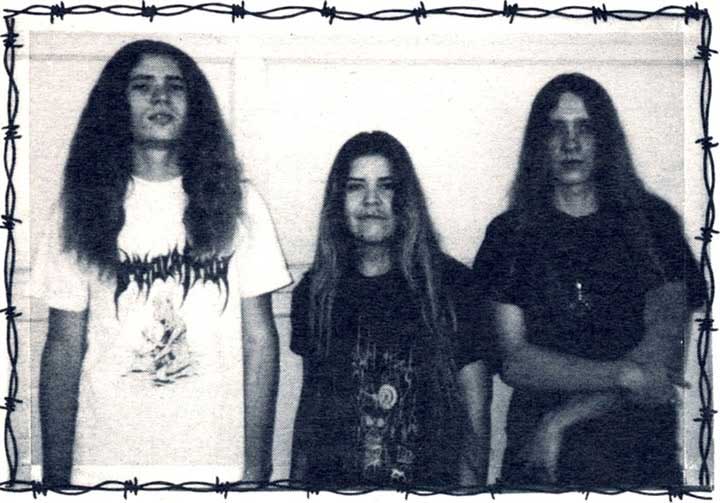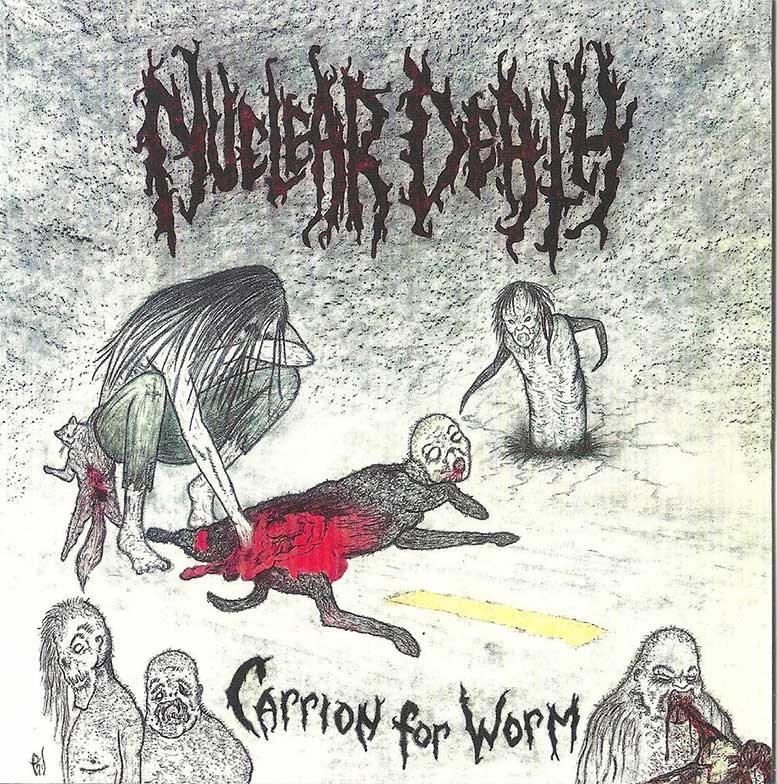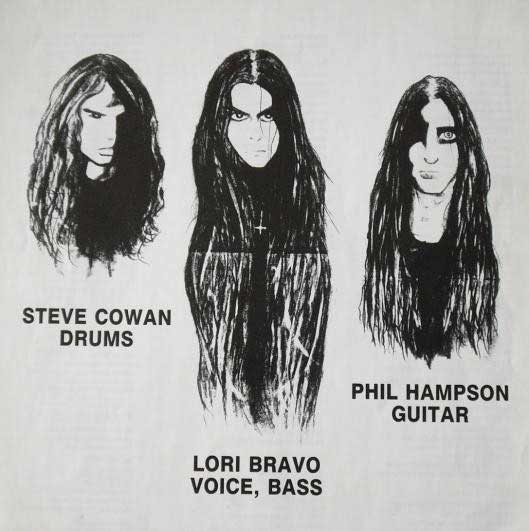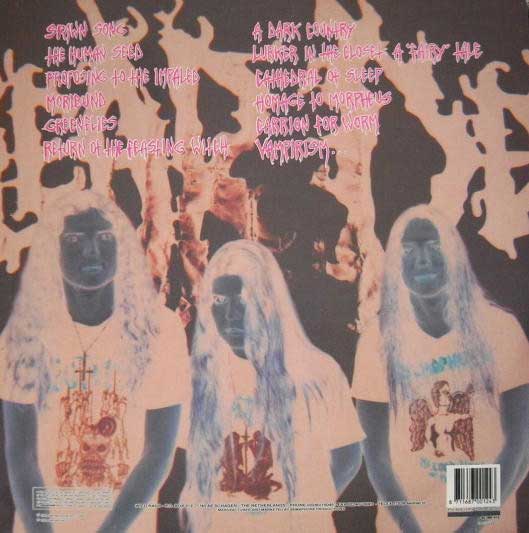Nuclear Death IV
2025-07-16
by Niklas Göransson
Carrion for Worm – psalms of hollow grandeur. Fevered, fragmented, and steeped in unspoken tension, Nuclear Death’s second album radiates the dread of something sacred coming undone.
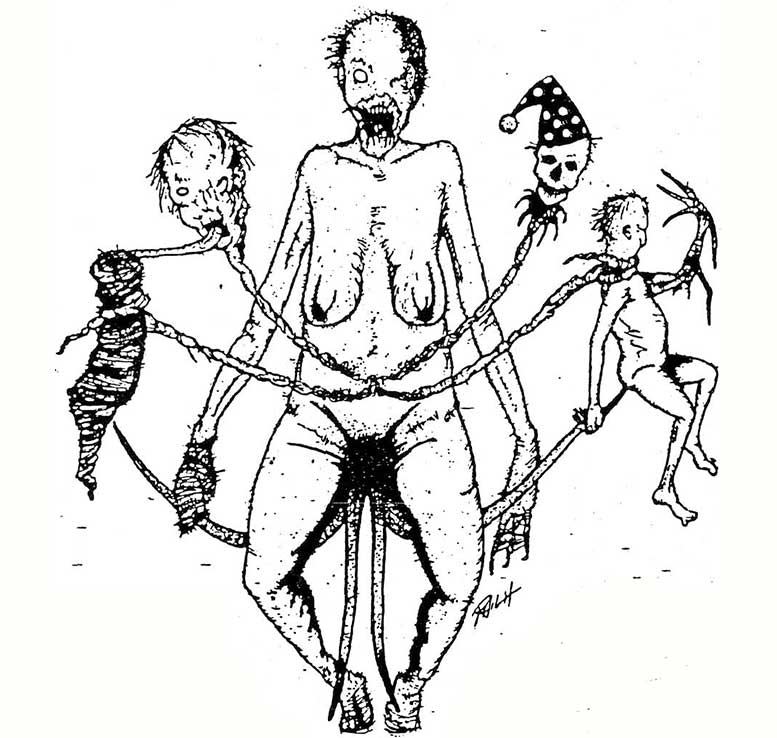
LORI BRAVO: There’s so much angst and horror tied into “Carrion for Worm” that I’m almost reluctant to talk about it. I didn’t yet know I had an anxiety disorder – it felt as if I was constantly being dragged to the edge, especially dealing with Phil. Fortunately, the music made it bearable.
When Steve Cowan replaced Joel Whitfield on drums in late 1990, Lori Bravo and Phil Hampson had already written and arranged most of NUCLEAR DEATH’s second album, “Carrion for Worm”.
LORI: Steve definitely helped shape the final arrangements. Like I’ve said: he’s a true musician, same as me. Not just classically trained, but he had that second sight – the intuition you need to really understand where a song is headed. Steve stepped in and made everything way better.
Musically, “Carrion for Worm” keeps one foot in the demented deathgrind of “Bride of Insect” but leans more decisively into brutality. It also introduces experimental textures such as the opening of “Vampirism”, which strongly foreshadows the band’s later direction.
LORI: Steve and I put that one together. We were listening to a lot of classical music at the time: Rachmaninoff, Bartók… just playing around, pulling ideas from various sources – experimenting with different melodies and twisting them into something unique.
Did you write the entire song or just the intro?
LORI: Phil wrote the rest. Knowing how much I adored vampires, I think it was his attempt at a love song. Probably sensing a shift between us, “Vampirism” became Phil’s way of trying to hold onto me. Maybe he thought it would change my mind.
Around this time, Lori was drifting apart from Phil – both creatively and personally – while developing a long-distance connection with AUTOPSY frontman Chris Reifert.
LORI: Chris and I had been exchanging letters and sharing ideas. AUTOPSY hadn’t done “Retribution for the Dead” yet, so he’d send me rehearsal tapes of what they were working on. I did the same with “Carrion for Worm”. Now, I don’t remember who started it <laughs>, but we eventually began exchanging photos.
Lori had Chris send mail to her workplace at Deluxe Carpet Cleaning so Phil – whose parents’ house they lived in – wouldn’t notice.
LORI: Phil always went to bed early, so I’d stay up bored, call Chris and chat for hours. One time, Phil’s brother caught on that I was on the phone with someone I probably shouldn’t be talking to. Phil confronted me, but I brushed it off, ‘Oh, that’s just Chris Reifert from AUTOPSY.’
And in that moment, the guest vocal idea was spontaneously conceived.
LORI: I said, ‘We were discussing Chris doing some vocals on “Carrion…” – what do you think?’ Total cover story. Phil went, ‘Yeah, great idea!’ So, the plan became for Chris to visit Phoenix under the pretext of a guest appearance. We’d meet and… well, you know <laughs>. At least, that’s what I thought.
Chris arrived in Phoenix two days before NUCLEAR DEATH were scheduled to enter the studio. He was picked up at the airport by Lori and Phil and then brought back to their place.
LORI: Every time Phil was in the shower or distracted, Chris and I would try to make out, yet nothing clicked. Turns out, we were only compatible over the phone. I didn’t even know one could fall in love with someone’s voice, their words – but not them.
To complicate matters, the same day Reifert arrived, Lori came down with a nasty flu.
LORI: That same night, despite running a high fever, I had to do my damn paper route with Phil. Chris and Steve came along to help. Afterwards, just before heading home, Steve turned to me and said, ‘I love you, Lori. I’ll dedicate my life to you.’ I was like, ‘What?’ ‘I’m serious. I had to tell you.’
Okay, so just to place us in the moment: Lori is about to record the second NUCLEAR DEATH album – working alongside both her domestic partner and guitarist, Phil, and a long-distance amorous interest turned cold. Then, to top it all off, the band’s new drummer professes his love for her.
LORI: Pretty much. The next day, we threw a party in our rehearsal room. Sadly, I ignored Chris the entire time because I felt consumed by the realisation of having picked the wrong person. I liked Chris – still do – but at that moment, I just knew: Steve was my destiny.
It was a motley crew indeed that entered Vintage Recorders on February 24, 1991. The vocalist had a forty-degree (104°F) fever, and the interpersonal tension bordered on theatrical, with everyone present caught up in some emotional entanglement – except for the engineer, who apparently didn’t understand their music at all.
LORI: Oh God… the guy hadn’t the faintest idea what the fuck he was doing. We chose the wrong place, simple as that. Don’t ask me why we didn’t just go back to Joe Crow. Oh, wait. Right – we couldn’t. He’d vanished, which is the only reason we didn’t record with him.
At the time, Vintage Recorders’ studio engineer and owner, Billy Moss, had very limited experience with metal.
LORI: Nice setup, but really expensive. Billy told me he’d recorded Stevie Nicks (FLEETWOOD MAC), even reminiscing about the sound of her bracelets jingling during a take. I thought, ‘Oh, wow.’ Turns out, she’d never set foot in his studio – he’d just edited some of her stuff. Fitting, though, as our situation resembled that of “Rumours”. Same energy.
FLEETWOOD MAC’s 1977 classic “Rumours” was famously recorded amid collapsing relationships and emotional crossfire, with Stevie Nicks and Lindsey Buckingham breaking up, Christine and John McVie divorcing, and Mick Fleetwood discovering his wife’s affair. Lyrics were often pointed barbs aimed across the studio, while band members recorded vocal takes in isolation to avoid speaking to one another.
LORI: When Chris and I tracked the vocals for “Vampirism” and “Cathedral of Sleep”, he was literally holding me up. Fevered and coughing, I knew people would be excited to hear two legendary singers together, so I gave it everything I had. My vocals work – but they’d be a million times better if I hadn’t been sick.
Lori’s voice is noticeably deeper and more guttural than earlier material, something she attributes to the flu rather than stylistic intent.
LORI: Nevertheless, I was already aiming to sing deeper. By 1991, we’d started noticing newer bands in a vein similar to NUCLEAR DEATH. Or… not like ours, we were miles ahead – but still operating in that general zone. Anyway, those vocals? To me, they’re flat. Devoid of dynamics and expression.
What the voice may lack in range is arguably compensated for by immersion. Take the closing part of “Return of the Festering Witch”, where Lori genuinely sounds like a crazed sorceress.
LORI: Yeah, you can almost taste the claustrophobia because that’s exactly what it felt like to me, pulled in opposite directions by different men and conflicting ideas. And then there was Phil’s chokehold – literal and emotional. So yes, there’s definitely a sense of being crushed or smothered in there.
Being feverish and emotionally unravelled seems like the ideal state to convey lyrics about rape, incest, cannibalism, necrophilia, and mutilation – rendered with graphic detail yet poetic weight.
LORI: I probably fed all that into the performance without even realising. I wasn’t singing about myself – they weren’t my lyrics. I was playing characters. But the feeling came through. Again, I don’t think my vocals suck; they’re just not as great as they could’ve been. Nonetheless, the whole album fell short of its potential.
You’re referring to the production?
LORI: Yep. With decent sound, “Carrion…” would’ve blown “Bride of Insect” out of the water. The songs were brilliant – masterpieces. You can hear the progression, something nobody else had done before and honestly still hasn’t. In that sense? Yeah, it holds value.
The production is often described as hollow and bass-heavy – especially the kick drum, which overwhelms the mix and obscures the guitars. Some reviewers have interpreted this murky, suffocating soundscape as intentional aesthetic oppression, but it wasn’t a calculated decision at all.
LORI: Definitely not; we even had it remixed twice by two different engineers. The second was Rusty from a studio called Chaton Recordings, which kicked ass – great gear, cool people. He brought “Carrion…” back from the dead and gave us something we could actually release.
Were you paying for this?
LORI: You bet; Phil and I ended up spending a fortune trying to salvage the sessions. Everyone’s performances were spot-on, so the issue wasn’t our playing – it was the engineering. When we told Billy, ‘You didn’t even mix it right’, he still demanded full payment. And then… boom! The fucking studio burned down.
Did you have an alibi?
LORI: <laughs> No – if I’d done it, MAYHEM-style, I would’ve grabbed our tapes first. We’d been trying to buy the masters, but Billy held them hostage. It’s not that we didn’t want to pay; we’d just run out of money remixing it. But yeah, the studio burned, and any hope of a proper remix went up in ashes with it.
Do you think a third attempt would’ve been more successful?
LORI: With the technology available now, I’m sure someone could finally bring out what it was meant to be: big and voluminous. It could sound so much better – clearer and punchier. Consider a track like “Cathedral of Sleep”: when you hear the word cathedral, you should feel that spooky, resonant vibe like you’re inside some vast church.
“Carrion for Worm” was released by Wild Rags Records in June 1991, just three months after being recorded, and became NUCLEAR DEATH’s most transgressive and challenging artistic statement to date. Unfortunately, the visual presentation didn’t match its intensity – the cover art, drawn by Phil, feels comparatively uninspired.
LORI: Right then, I knew Phil would never draw another NUCLEAR DEATH cover; he totally dropped the ball. If he’d just been upfront and shown me what he was – or wasn’t – working on, I’d have taken the pencil myself. But things played out the way they did, which fucking sucked.
Despite its originality, “Carrion for Worm” received very little press – even from publications that typically championed the underground.
LORI: We got a lot of fan mail, and I answered everyone I could. We were in tonnes of fanzines, which helped spread the word, I guess. But we never saw any coverage in bigger magazines, didn’t tour, and received zero real promotion. Not for “Carrion for Worm”, and not for “Bride of Insect”. Wild Rags did a shit job across the board.
Did you notice any tangible uptick in interest from Chris Reifert’s guest appearance?
LORI: Nah, people still hated us. AUTOPSY had a proper label – Peaceville – and were touring overseas, doing big things. That’s where we wanted to be. Chris talked about bringing us on the road; he even sent a plane ticket, inviting me to come live with him, and offered to play drums for me. But when I said, ‘Sorry, I’m staying in Phoenix’, well… no more tour.
log in to keep reading
The second half of this article is reserved for subscribers of the Bardo Methodology online archive. To keep reading, sign up or log in below.

